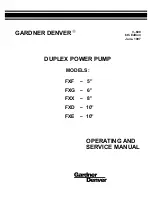
6
In case of water shortage the pump tries to discharge water for approximately 40 seconds and then stops for 10
seconds. Then the pump tries to start again and will repeat this start cycle in total 3 times. After a break of 60
minutes, the pump will try again 4 start cycles. If it is still not possible by that time to discharge water, because
e.g. the intake openings is clogged or the water level is too low, the pump will indicate an error (error modus) and
cannot be started without help from the user. Make sure you remove the reason for dry running and the water
level is sufficient for operating the pump. In order to restart the pump, you must rest the pump by unplugging the
power cord for approximately 10 seconds. The pump will start operation by connecting the power cord again to
the electric power supply.
9. Maintenance and troubleshooting
Prior to carrying out any maintenance work, the pump must be separated from the electrical
mains. If you fail to separate the unit from mains, there is a risk of an inadvertent start of the
pump.
We decline any liability for damage caused by inappropriate repair attempts. Any damage
caused by inappropriate repair attempts will avoid all warranty claims.
Observing the conditions of use and the ranges of application of the present device will reduce the risk of possible
operational malfunction and contribute to extend the lifetime of your unit. Sand and other abrasive matters
contained in the liquid discharged will speed up the process of wearing and tearing and accelerate the drop in
performance.
If the unit is operated properly, it will not require any maintenance.
If the water pumped is not sufficiently clean, it may be necessary to clean the intake filter (4) with a steel brush in
order to remove the dirt that has accumulated on the outer surface. To do this the pump must be disconnected
from the electrical power supply and taken out of the water. If this external cleaning is not sufficient then the
stainless steel filter panel (4) can be removed from the pump by loosening the two Philips-head screws (fig. 3).
Then the internal side of the intake filter (4) can also be cleaned with a steel brush. The filter panel should then be
rinsed with clean water and re-fitted to the pump (fig 4). Any further disassembly and the replacement of parts
must only be carried out by the manufacturer or authorized customer support personnel, in order to avoid
hazards.
Disassembly
Assembly
If necessary, it is recommended to clean the intake filter (4) which can be detached from the pump after loosening
the appropriate screws. Subsequently, please use a steel brush to clean the inner and outer surface of the intake
filter. To conclude the cleaning process, please flush the intake filter with clear water and reattach it to the pump.
Cleaning of the hydraulic parts may only be performed by an authorised specialised dealer or customer service.
To avoid any hazard, any further disassembly as well as the replacement of parts must only be done by the
manufacturer or a by an authorised service provider.
Water left in the pump may freeze in case of frost and thus cause considerable damage. Therefore, the pump
must be removed from the liquid being discharged and fully drained when temperatures are below the freezing
point of the liquid. Please store the pump in a dry, frost-protected place.
In the case of malfunction, you should first of all check whether it was caused by an operating error or some other
reason which cannot be attributed to a defect of the device - for instance a power failure.
The list below shows some possible malfunctions of the device, possible causes and tips on their elimination. All
the measures referred to may only be carried out with the pump being separated from the electrical mains. If you
yourself feel unable to eliminate any of these malfunctions, please contact the customer service department or
your point of sales. Any repair beyond the scope specified below must only be performed by qualified staff.
Fig.3
Fig.4
14





































